This sauerkraut is literally the fastest sauerkraut you will ever make. No need for hours of slicing the cabbage leaves. No heavy pottery crocks to scald and sanitize. And it’s ready in just a week when you make it in a one quart jar. So if you’ve been procrastinating getting fresh sauerkraut brewing on your counter in the middle of winter; if you’re just too busy to take a cabbage and slice it up; if you have too many commitments to spend an extra hour in the kitchen; or if the $20 a quart price on raw sauerkraut isn’t enough motivation to make your own, this recipe will move you to action.
Why make your own sauerkraut at home
- It’s easy
- It’s fun
- There’s only 2 ingredients
- You can customize the vegetables to family preferences
- You control how much salt to use
- You can add herbs and spices for variety
- You tap into the unique probiotics in your location
- You bypass government controls that are anti-health, but pro-corporate profits
- You get more healthy probiotics with less time and less money
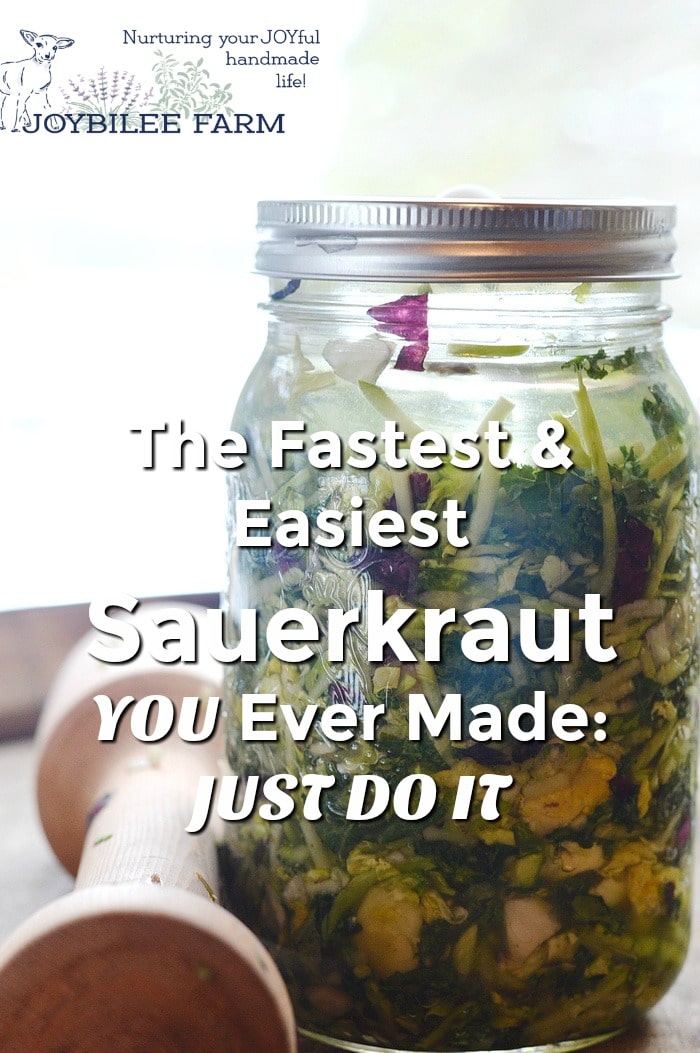
Steps to making conventional sauerkraut
- Chop or shred cabbage, carrots, and radishes to uniform sizes
- Salt vegetable to draw out juices
- Crush vegetables to break the fibrous leaves and draw out juices
- Place in jars or containers
- Add water to cover if necessary
- Place weight to keep vegetables under the surface and prevent mold
- Place air lock
- Wait 5 to 20 days for the sauerkraut to finish fermenting
- Refrigerate finished sauerkraut and eat
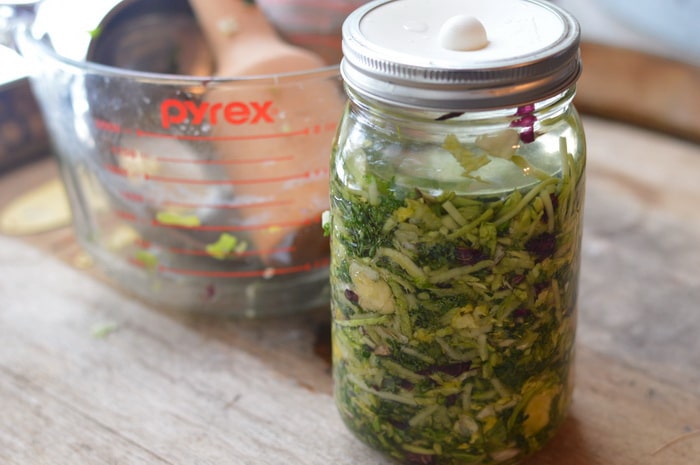
This small batch sauerkraut recipe is ready in just 5 days. All the time consuming shredding and cutting is done for you. There’s no excuses now. Just open the bag, salt, crush, jar and wait. In 5 days or so you can remove the fermentation lock and glass weight and place the finished sauerkraut in the fridge. You can eat it immediately or allow the flavors to develop a little longer. It will keep in the fridge for up to a year with no loss of quality. But don’t wait a year. Consume a little every day for the probiotic health benefits.
Why eat fermented vegetables every day?
- Fermented vegetables support your healthy microbiome
- They aid with weight loss
- Support the immune system
- Help your brain function and process better
- Promote positive emotions
- Improves digestion
- Promotes regularity
- Can reduce inflammation and pain in the body
- Can improve gut flora after antibiotics
- Compensates for the reduction in stomach acids in older adults
- Increased availability of vitamins and minerals, especially vitamin C
- Reduces the risk for breast cancer and other cancers
- Increases pancreatic enzymes that help to break down food in the gut
- Makes proteins and fats easier for the body to digest
- Improves skin health
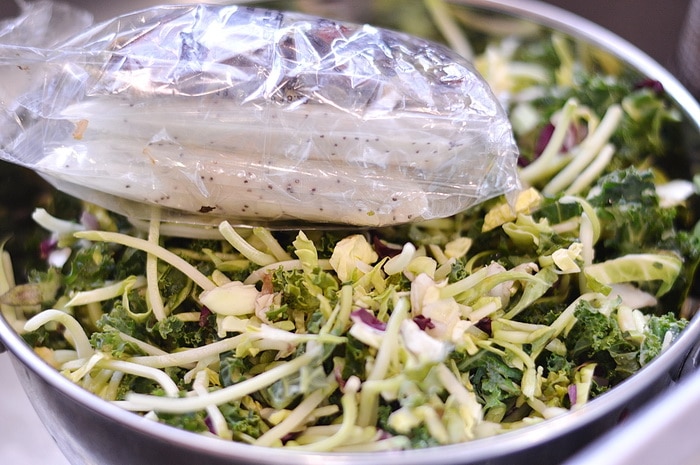
This recipe for sauerkraut begins with a 20 ounce (600 gram) bag of sweet kale salad. This kind of salad can be found in most grocery stores in the produce section with the bagged salads. You could also use a cole slaw mix instead. 20 ounces is just the right amount to fill a quart jar for this recipe. We’re looking for fast and easy here, just to get that kraut into the jar as quickly as possible. However, if you grow your own sweet kale salad using a mixture of hardy kale, grated broccoli stems, Brussel sprouts and a little red radicchio for color.
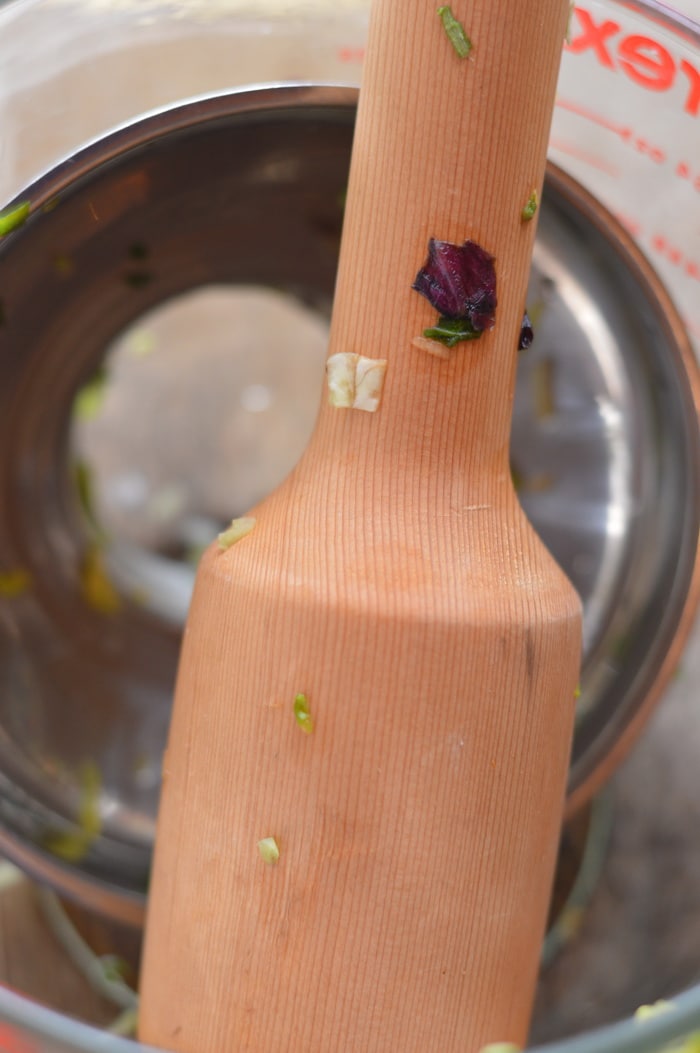
Equipment for small batch fermentation
You’ll also need:
- A wide mouth quart jar with a screw band
- A silicone fermentation lock like this one
- A glass weight like this one
- A plate to catch the drips if the jar overflows
- A wooden kraut pounder or other way to crush the vegetables and release their juices
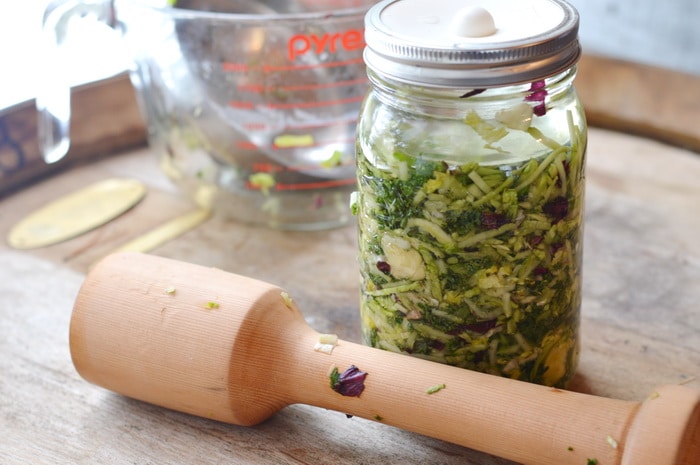
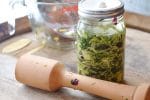
Small Batch Sauerkraut the Easy Way
- Prep Time: 15 minutes
- Total Time: 15 minutes
- Yield: 1 quart 1x
Description
This quick and easy sauerkraut recipe begins with a 20 ounce bag of sweet kale salad mix. You won’t use the dressing or the cello bag of pumpkin seeds and cranberries. Save those for another salad. The only other ingredient you’ll need is some Himalayan salt.
Ingredients
- 1 28 ounce bag of Sweet Kale Salad Mix
- 2 teaspoon Himalayan salt, fine grain
Instructions
- Empty the salad bag into a colander and rinse the salad greens. Let them drain naturally for 15 minutes, or spin in a salad spinner. Set aside the enclosed salad dressing and pumpkin seed/cranberry garnish for another recipe.
- Place the washed salad greens into a bowl. Sprinkle salt over the salad greens.
- Pound with a kraut pounder until the salad greens are well bruised and the juices begin to flow.
- Transfer the salad greens to a sanitized quart jar. Press down with the kraut pounder. Add water to cover the greens.
- Place sanitized glass weight into the mouth of the jar. Press down so that the liquid in the jar comes over the top of the glass weight. Place fermentation lock in the top of the jar and secure in place with the screw bad. Set on a plate to catch any overflow. Place out of direct sunlight and heat so that it can ferment naturally. There is no need to add any probiotic culture to the jar. The culture needed to ferment the cabbage is already on the outside of the vegetables.
- After 24 to 48 hours the vegetables in the jar will begin to bubble. The pressure inside the jar will build up and the silicone lid will bulge up on the top of the jar. During this time the liquid in the jar becomes more acidic and 3 different beneficial bacteria colonize the jar and then die off. In the final act, the pressure in the jar reduces and the lacto-bacteria have finished colonizing the jar. The fermentation can now be moved to develop flavors.
- Remove the fermentation weight and the silicone fermentation lock. Replace the lid on the jar with a normal lid. Refrigerate the jar or move it to a cool, dark room to finish developing complex flavors or eat immediately.
- Sauerkraut will keep up to a year in the fridge. Do not eat if mold develops on the surface of the jar or if the jar smells “off” or putrid.
Notes
The high acidity of sauerkraut prevent botulism from growing in the jar. A milky yeast can grow in jars of fermented vegetables. This yeast is not harmful and doesn’t affect the safely of fermented vegetables. However it can affect the flavor and the presentation.
If you have been trying to get more fermented vegetables on the table but you don’t have the time to cut up cabbages, radishes, and more, this small batch, two ingredient sauerkraut will get you there faster. Plus it both looks and tastes great. The flavor improves if you leave it in the fridge for 3 weeks before you consume it. So don’t let time rob you of this healthy probiotic rich food any longer. Grab that bag of sweet kale salad on your next trip to the grocery store and get this fast sauerkraut working for YOUR health and good digestion.
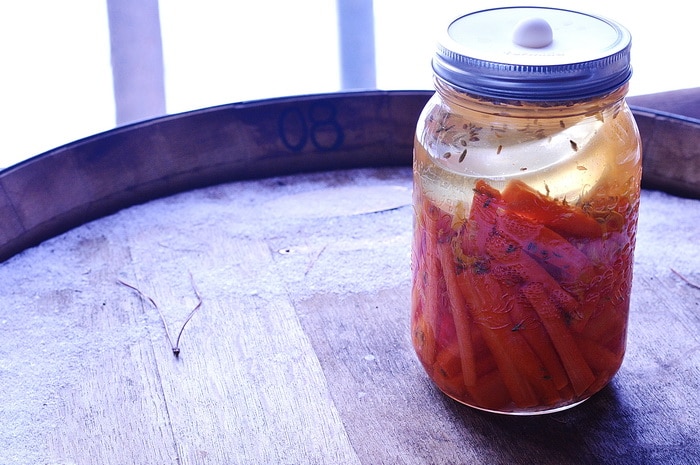
Other probiotic-rich fermented vegetable recipes to try on Joybilee Farm:



I wanted to try the recipes but your advertisers immediately cover up the recipe with their ads. I can’t hit the print button fast enough to avoid them. Attempts to get them off the recipe just invited more ads changing frustration to anger. Please tell your advertisers the practices they are using on your blog is preventing at least myself from enjoying the benefits of what you have to offer.